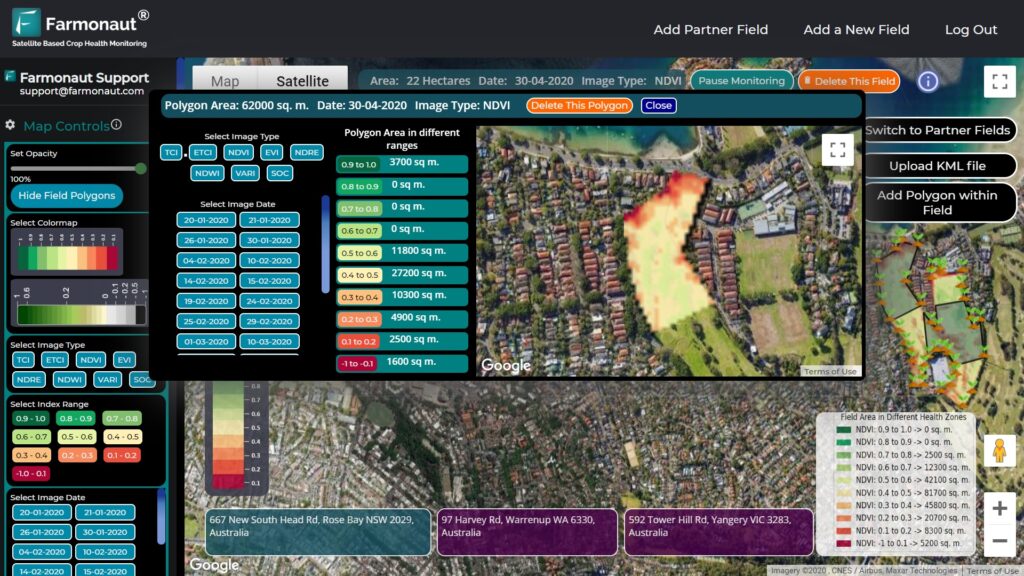US Agriculture Policy Shift: New USDA Leadership Aims to Revitalize Rural America and Boost Global Competitiveness
“The 2023 Farm Bill is a key priority for the new USDA leadership, impacting millions of American farmers and ranchers.”
As we delve into the latest developments in US agriculture policy, we find ourselves at a pivotal moment for rural America and the agricultural industry as a whole. The recent confirmation of Brooke Rollins as the new leader of the United States Department of Agriculture (USDA) signals a renewed focus on supporting farmers, ranchers, and the broader agricultural community. This shift in leadership brings with it a host of potential changes that could reshape the landscape of American agriculture and its role in the global marketplace.
A New Era for US Agriculture Policy
The appointment of Brooke Rollins as the 33rd US Secretary of Agriculture marks the beginning of a new chapter in American agricultural policy. With her background in agricultural development from Texas A&M University and her experience in policy-making, Rollins brings a unique perspective to the USDA. Her confirmation by the Senate, with a vote of 72 to 28, demonstrates bipartisan support for her vision to revitalize rural America and enhance the competitiveness of US agriculture on the global stage.
In her first statement as Secretary, Rollins emphasized her commitment to fighting for American farmers, ranchers, and the agriculture community. She highlighted the historic opportunity to breathe new life into rural America and ensure that US agriculture remains a world leader for generations to come. This vision aligns closely with the pressing needs of the agricultural sector and the rural communities that support it.

Key Priorities Under the New USDA Leadership
As we analyze the potential impact of this leadership change, several key priorities emerge that are likely to shape US agriculture policy in the coming years:
- 2023 Farm Bill: The development and passage of a robust farm bill is a top priority for the new USDA leadership. This comprehensive legislation will set the stage for agricultural and food policy for the next several years, addressing everything from crop insurance to nutrition programs.
- Grain Transportation Infrastructure: Improving the infrastructure for transporting grain and other agricultural products is crucial for enhancing the efficiency and competitiveness of US agriculture.
- Global Agricultural Competitiveness: Strengthening the position of US agriculture in international markets is a key focus, with an emphasis on creating a level playing field for American producers.
- Rural Economy Development: Initiatives aimed at revitalizing rural communities and creating new opportunities for agribusinesses are at the forefront of the USDA’s agenda.
- Regulatory Framework: Efforts to streamline and modernize agricultural regulations to spur investment and innovation across the food and agriculture sector are expected.
These priorities reflect a comprehensive approach to addressing the challenges and opportunities facing US agriculture today. By focusing on these areas, the USDA aims to create a more resilient, competitive, and prosperous agricultural sector that can thrive in an increasingly complex global marketplace.
Industry Reactions and Collaborations
The confirmation of Secretary Rollins has been met with optimism from various agricultural industry associations. Organizations such as the National Grain and Feed Association (NGFA), the National Association of Wheat Growers (NAWG), and the American Feed Industry Association (AFIA) have expressed their support and eagerness to work with the new USDA leadership.
Mike Seyfert, President and CEO of the NGFA, highlighted the importance of advancing priorities that align with the needs of American agriculture. These include:
- Developing robust transportation infrastructure
- Ensuring a level playing field in international markets
- Implementing policies to help the rural economy prosper
- Reducing regulatory burdens to encourage efficiency and investment
The NAWG, represented by CEO Chandler Goule, expressed appreciation for Rollins’ commitment to providing economic assistance for wheat producers and her interest in signing a long-term farm bill this year. This collaboration between the USDA and industry associations is crucial for developing effective policies that address the real-world challenges faced by farmers and ranchers.
Technological Advancements in Agriculture
As we consider the future of US agriculture under this new leadership, it’s important to recognize the role of technological advancements in shaping the industry. Companies like Farmonaut are at the forefront of this agricultural revolution, offering innovative solutions that align with the USDA’s goals of increasing productivity, sustainability, and competitiveness.
Farmonaut’s satellite-based farm management solutions provide valuable tools for farmers and agribusinesses, enabling them to make data-driven decisions that optimize crop yields and resource management. These technologies support the USDA’s objectives by:
- Enhancing farm productivity through real-time crop health monitoring
- Promoting sustainable farming practices with precision agriculture techniques
- Improving supply chain transparency using blockchain-based traceability
- Supporting rural economic development by making advanced agricultural technologies accessible to farmers of all scales
The integration of such technologies into US agriculture policy could play a significant role in achieving the USDA’s goals of revitalizing rural America and boosting global competitiveness.
“US agriculture policy shifts aim to boost global competitiveness, potentially affecting billions in international trade relationships.”
Global Agricultural Competitiveness
One of the key focuses of the new USDA leadership is enhancing the global competitiveness of US agriculture. This involves a multi-faceted approach that includes:
- Negotiating favorable trade agreements
- Promoting science-based agricultural standards internationally
- Investing in research and development to maintain technological leadership
- Supporting farmers in adopting innovative practices and technologies
The AFIA has emphasized the importance of maintaining science-based standards and regulations as a top priority in international negotiations. This approach is crucial for ensuring that US agricultural products remain competitive in global markets while maintaining high standards of quality and safety.

Revitalizing Rural America
The revitalization of rural America is a central theme in the new USDA leadership’s agenda. This focus recognizes the vital role that rural communities play in the agricultural sector and the broader economy. Initiatives aimed at revitalizing these areas include:
- Improving rural infrastructure, including broadband internet access
- Creating new economic opportunities in rural areas
- Supporting small and medium-sized farms
- Enhancing access to healthcare and education in rural communities
By strengthening rural economies, the USDA aims to create a more resilient agricultural sector that can better withstand economic challenges and continue to provide food security for the nation.
The Role of Technology in Modern Agriculture
As we look to the future of US agriculture under this new leadership, the role of technology cannot be overstated. Advanced agricultural technologies, such as those offered by Farmonaut, are becoming increasingly important in achieving the USDA’s goals of increased productivity, sustainability, and competitiveness.
Farmonaut’s suite of tools, including satellite-based crop health monitoring, AI-driven advisory systems, and blockchain-based traceability solutions, align closely with the USDA’s objectives. These technologies enable farmers to:
- Make data-driven decisions to optimize crop yields
- Implement precision agriculture techniques for more sustainable farming
- Enhance supply chain transparency and traceability
- Improve resource management and reduce environmental impact
The integration of such technologies into US agriculture policy could play a significant role in achieving the USDA’s goals of revitalizing rural America and boosting global competitiveness.
USDA Policy Priorities and Impacts
| Policy Area | Current Status | Proposed Changes | Potential Impacts |
|---|---|---|---|
| 2023 Farm Bill | Existing challenges in supporting farmers and rural communities | Comprehensive legislation addressing crop insurance, nutrition programs, and rural development | Enhanced support for farmers, improved food security, and stronger rural economies |
| Grain Transportation Infrastructure | Aging infrastructure causing inefficiencies in grain transport | Investment in modernizing transportation networks and facilities | Improved efficiency in moving agricultural products, reduced costs for farmers |
| Global Competitiveness | Challenges in international markets due to trade barriers and competition | Negotiation of favorable trade agreements, promotion of science-based standards | Increased market access for US agricultural products, improved export opportunities |
| Science-Based Agricultural Standards | Varied standards across international markets | Push for harmonized, science-based standards in global trade | Level playing field for US producers, enhanced food safety and quality assurance |
| Rural Economic Development | Economic challenges in many rural areas | Targeted investments in rural infrastructure, education, and business development | Creation of new jobs, improved quality of life in rural communities, reduced urban-rural divide |
The Importance of Science-Based Agricultural Standards
One of the key priorities emphasized by industry associations is the importance of maintaining and promoting science-based agricultural standards. This approach is crucial for several reasons:
- Ensuring food safety and quality
- Maintaining consumer confidence in US agricultural products
- Creating a level playing field in international markets
- Driving innovation and technological advancement in the agricultural sector
The AFIA has expressed its support for Secretary Rollins in her diplomatic efforts to ensure that science-based standards and regulations remain a top priority in international negotiations. This focus aligns with the broader goal of enhancing US agricultural competitiveness on the global stage.
Supporting Domestic Markets and Biofuels
While international competitiveness is a key focus, the new USDA leadership is also committed to strengthening domestic markets. John Bode, President and CEO of the Corn Refiners Association, highlighted the importance of advancing the interests of American agriculture and related industries, which account for 20% of America’s economy.
One specific area of focus is the biofuels industry. The American Coalition for Ethanol has expressed interest in working with Secretary Rollins on tax incentives such as the 45Z Clean Fuel Production credit. This initiative could have significant implications for:
- Reducing dependence on fossil fuels
- Creating new markets for agricultural products
- Supporting rural economies
- Promoting environmental sustainability
By supporting the development of domestic markets, including the biofuels sector, the USDA aims to create a more diversified and resilient agricultural economy.
The Role of Technology in Achieving USDA Goals
As we consider the ambitious goals set forth by the new USDA leadership, it’s clear that technology will play a crucial role in their achievement. Advanced agricultural technologies, such as those offered by Farmonaut, align closely with the USDA’s objectives of increasing productivity, sustainability, and competitiveness.
Farmonaut’s suite of tools includes:
- Satellite-based crop health monitoring
- AI-driven advisory systems
- Blockchain-based traceability solutions
- Fleet and resource management tools
These technologies support the USDA’s goals by:
- Enabling data-driven decision-making for farmers
- Promoting sustainable farming practices through precision agriculture
- Enhancing supply chain transparency and traceability
- Improving resource management and reducing environmental impact
The integration of such technologies into US agriculture policy could significantly contribute to the revitalization of rural America and the enhancement of global competitiveness.
For those interested in leveraging these advanced agricultural technologies, Farmonaut offers several ways to access their services:
- Web Application
- Android App
- iOS App
- API Access for developers and businesses
Additionally, for those looking to support the adoption of these technologies while earning income, Farmonaut offers an affiliate program:
Earn With Farmonaut: Affiliate Program
Earn 20% recurring commission with Farmonaut’s affiliate program by sharing your promo code and helping farmers save 10%. Onboard 10 Elite farmers monthly to earn a minimum of $148,000 annually—start now and grow your income!
Challenges and Opportunities Ahead
As the USDA embarks on this new direction under Secretary Rollins’ leadership, there are both challenges and opportunities on the horizon. Some of the key challenges include:
- Balancing the needs of different agricultural sectors
- Addressing climate change and environmental concerns
- Navigating complex international trade relationships
- Ensuring food security while promoting sustainability
However, these challenges also present opportunities for innovation, collaboration, and growth. By leveraging advanced technologies, fostering partnerships between government, industry, and academia, and maintaining a commitment to science-based policies, the US agricultural sector can emerge stronger and more resilient.
Conclusion: A New Chapter for US Agriculture
The confirmation of Brooke Rollins as the new leader of the USDA marks the beginning of an exciting new chapter for US agriculture. With a focus on revitalizing rural America, enhancing global competitiveness, and leveraging advanced technologies, the USDA is poised to address the challenges facing the agricultural sector head-on.
As we move forward, the collaboration between government agencies, industry associations, and technology providers like Farmonaut will be crucial in realizing the full potential of American agriculture. By embracing innovation, promoting sustainable practices, and supporting rural communities, we can ensure that US agriculture remains a global leader for generations to come.
The road ahead may be challenging, but with strong leadership, innovative technologies, and a commitment to science-based policies, the future of US agriculture looks bright. As stakeholders in this vital industry, we all have a role to play in shaping this future and ensuring the continued success and sustainability of American agriculture.
FAQ Section
Q: What are the main priorities of the new USDA leadership?
A: The main priorities include passing the 2023 Farm Bill, improving grain transportation infrastructure, enhancing global competitiveness, promoting science-based agricultural standards, and revitalizing rural America.
Q: How does the new USDA leadership plan to support farmers and ranchers?
A: The USDA plans to provide economic assistance, improve infrastructure, negotiate favorable trade agreements, and promote the adoption of innovative technologies to support farmers and ranchers.
Q: What role does technology play in the new USDA agenda?
A: Technology plays a crucial role in achieving the USDA’s goals. Advanced agricultural technologies, such as those offered by Farmonaut, are seen as key to increasing productivity, sustainability, and competitiveness in the agricultural sector.
Q: How does the USDA plan to enhance global competitiveness for US agriculture?
A: The USDA plans to negotiate favorable trade agreements, promote science-based standards internationally, invest in research and development, and support farmers in adopting innovative practices and technologies.
Q: What initiatives are planned for rural America revitalization?
A: Initiatives include improving rural infrastructure (including broadband internet access), creating new economic opportunities, supporting small and medium-sized farms, and enhancing access to healthcare and education in rural communities.










